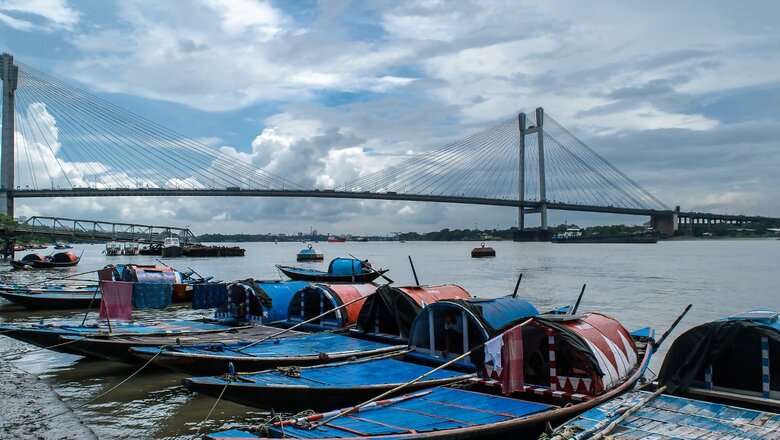
views
It has been a year since unprecedented violence took place in West Bengal after the Assembly election results were announced. Why Bengal has been suffering violence (both West Bengal and Bangladesh)? What was the original demographic composition of Bengal and how it has changed; and how this has affected the socio-political milieu in this region? This multi-part series would attempt to trace the origin of socio-political trends in the larger Bengal region (state of West Bengal and Bangladesh) over the last several decades. These trends are related to the evolution of Bengal over the last 4000 years. It’s a long journey and unfortunately most part of it has been forgotten.
Islamisation of Bengal is one of the key factors that has shaped the present-day polity in both West Bengal and Bangladesh. So it is important to understand how Islam spread rapidly in Bengal.
The Islamisation of Bengal began in early 13th century with the attack of Muhammad Bakhtiyar Khilji. In 1201, Khilji attacked a place called Nadia, also known as Nabadwip, a holy place of Hindus ruled by Sena kings. He captured some parts of Bengal. The Hindu kings, however, continued to rule significant parts of Bengal, even as Islam gradually started spreading in Bengal.
From 1201 till 1765, several parts of Bengal were ruled by Muslims but it is also a fact that there were several Hindu kings and kingdoms who not only existed but valiantly resisted the process of Islamisation. That is one of the key reasons why a significant population of Bengal remained Hindu.
It is a well-documented fact that one of the key focus areas of Muslim rulers in Bengal was to spread Islam by force and conversion. The result was that, according to 1891 census, Bengal housed almost half of the Muslim population of India.
Khondkar Fuzli Rubbee, dewan to the Nawab of Murshidabad, has given an interesting contemporary account in his work ‘Haqiqate Musalman-I-Bengalah’ whose English translation ‘The Origin of the Musalmans of Bengal’ was first published in 1895 by Thacker, Spink and Co. in Kolkata (at that time known as ‘Calcutta’).
Rubbee mentioned in the introduction of his work, “According to the results arrived at by the Census of 1891, there were 23,658,347 Musalmans in the province of Bengal.” The province of Bengal at that time comprised large parts of Bihar, present-day Jharkhand and large parts of Odisha. Out of this, the Muslim population in what is present-day ‘West Bengal and Bangladesh region’ was estimated at 19.5 million. “Thus, the number of Musalmans in Bengal proper amounts to more than one third of the entire Muslim population of India,” said Rubbee.
From 1201 till 1765, when the East India company got dewani of the Bengal after defeating the Muslim rulers of Bengal in the Battle of Plassey in 1757, the Islamic rulers of Bengal were often appointed by the ruling Muslim dynasties in Delhi as Nazims (Governors). At times, some of these rulers also declared their independence and tried to rule as sovereigns but they were ultimately defeated and punished.
“From 1204 AD to 1765 AD, that is to say during a period of 561 years, 76 Musalman Governors, Kings, and Nazims successively ruled Bengal. Out of these, 16 Governors held their appointments from Ghori and Khilji emperors, 26 were independent sovereigns, including the rulers who were contemporaneous with the reign of Shershah, and the remaining 34 were Nazims under the Mughal emperors. The 76 rulers who governed in this country during these 561 years were all of either Afghan, Moghul, Iranian or Arab origin, except Kans, Jalal-ud-din Shah, Ahmad Shah and Rajahs Todermal and Man Singh. Owing to this foreign origin … number of Musalmans of all classes and conditions came from Afghanistan, Turkistan, Iran, Arabia, distant parts of India and other countries, and settled in Bengal. Some of these Musalmans came with conquerors of Bengal, others came on account of disturbances and revolutions in their own native lands and came merely in search of employment or livelihood.” (Source: Rubbee, Pp23)
ALSO READ | The Bengal Conundrum: How Hindu Kings of Bengal Evolved a Perfect Model of Governance
Reasons for Islamisation of Bengal during Medieval Period
Rubbee had tried to make an argument that the spread of Islam in Bengal was largely due to the influx of Muslims from other countries in this region. In fact, he had put together this work specifically to propound this theory so that the theory of spread of Islam by forced conversions in Bengal could be negated. But what Rubbee said wasn’t the complete truth.
There is an important aspect to the spread of Islam in Bengal that needs to be mentioned here. Most western scholars, historians from colonial and Marxist schools as well as contemporary accounts by Muslim chroniclers have tried to put the onus of spread of Islam on caste-ridden Hindu society. Their argument has been that lower caste Hindus converted to Islam willingly to get rid of caste discrimination.
But historical evidence shows a different picture and this seems to be a deliberate and mischievous interpretation to brush under the carpet the bloodbath and cruelties Hindus suffered at the hands of Islamic invaders. Nitish Sengupta gives an example (Land of two Rivers, Pp84), “There were … some special economic disabilities imposed on non-Muslims especially by the early Turko-Afghan rulers. Ibn Batuta, who travelled in Bengal during the rein of Fakhr-ud-din and Mubarak Shah, recorded that in Sylhet, Hindus were compelled to give half of the crops they produced to the government and that there were several other impositions.”
In light of the above, it is important to understand that Islam spread in Bengal majorly due to forced religious conversions although influx of Muslims from other countries also played some part. When Mongol barbarian Genghis Khan and his successors ravaged the Muslim-ruled countries in the medieval period, a number of Muslims shifted to India which provided them with comfort and security.
Talking about these attacks, Rubbee says (Pp41-42), “All central and western Asia from Khorasan and Afghanistan to Baghdad, the seat of the Caliphate … which were under Moslem domination, fell into the tumult and convulsions owing to the invasion of Chengez Khan and his descendants … Consequently, these people fled to other countries for safety; and because of that time there was a powerful Musalman government in India, most of the refugees therefore fled into this realm.” However, as mentioned earlier, this influx contributed not so significantly to the spread of Islam in Bengal as forced conversions did.
However, the key factor was the forced conversion of Hindus. H. Beverley wrote in the Census Report of Bengal for 1872 (Para 348), “… Probably the real explanation of the immense preponderance of the Musalman religious elements in this portion of the delta is to be found in the conversion to Islam … The Mahaommedans (Muslims) were ever ready to make conquest with the Koran as with the sword. Under Sultan Jalal-ud-din, for instance, it is said that the Hindus were persecuted almost to extermination.”
Here it is important to bring to the fore the role played by Sufis in the spread of Islam in Bengal. Sir Jadunath Sarkar talked about their role in ‘The History of Bengal, Vol-II’ (Pp68), “These warrior saints of Medieval Bengal were the Knights-Templars of Islam with a cleaner record of morality, and also of loyalty to the temporal power than those of the Cross in Medieval Europe … These saints surrounded by a horde of less scrupulous followers used to enter the territory of Hindu Rajahs, as “squatters” on some pretext or other. Then they would bring down the regular army of the Muslim state upon these infidel kings to punish them for infringing the rights of Musalmans!”
Sengupta writes about the wandering Muslim ascetics also known as ‘dervishes’ (Pp83), “The influence of Sufism on many of these wandering ascetics is unmistakable. Some of these wandering dervishes also took to arms. It was one such dervish, Shah Jalal, who according to the local tradition, led a force of 3,000 dervishes that conquered Sylhet or Srihatta during the reign of Shams-ud-din Firuz Shah (AD 1301-22) at Gaur. The provocation for this armed raid was said to be the oppression of Muslims by Sylhet’s Hindu King Govindadev to punish Muslims for cow slaughter.”
As most of the chronicles, that historians have relied upon to recount the spread of Islam in Bengal during medieval period, rely on the accounts of Muslim chroniclers who were courtiers of the Muslim rulers or governors, many myths have been created through exaggeration about the prowess of Muslim warriors. The Hindu warriors resisted this onslaught of Islam but their valour has failed to make it to our history textbooks and the popular discourse on Bengal’s history. In next part of this series, we would deal with these myths and talk about the forgotten history of brave Hindu kings of Bengal during the medieval period.
You can read other articles in The Bengal Conundrum series here.
The writer, an author and columnist, has written several books. One of his latest books is ‘The Forgotten History of India’. The views expressed in this article are those of the writer and do not represent the stand of this publication.
Read all the Latest Opinions here




















Comments
0 comment